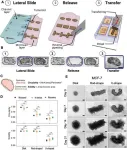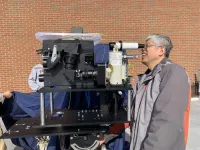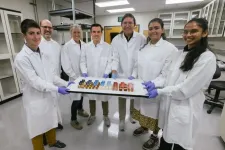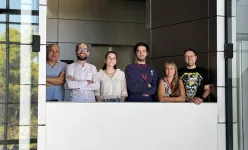(Press-News.org) A new paper in the journal Child Development shows how some aspects of family interaction among Indigenous people in Guatemala have fundamentally shifted with rapid globalization, yet families have still maintained a unique level of harmony in their interactions.
UC Santa Cruz psychologist Barbara Rogoff has been working with Mayan communities in San Pedro la Laguna, Guatemala for five decades and noticed a sophisticated type of fluid, inclusive collaboration among children from these communities. During a research study 30 years ago, mothers and their two small children interacted in a very distinct way, with all 3 people mutually engaged in exploring novel objects provided by the research team.
This type of collaboration is one of the foundational elements of a way of organizing learning that Rogoff and her collaborators have come to call Learning by Observing and Pitching In to family and community endeavors (LOPI). It’s a common traditional practice in many Indigenous and Mexican-heritage communities across the Americas, through which children learn by being involved alongside adults in the full range of daily activities of their family and community.
“Everyone contributes, taking initiative to collaborate and foster the direction of the group, and during these shared activities, children get feedback and corrections on their contributions,” Rogoff explained. “Over the years, increased understanding of this way of learning has inspired educators and developmental psychologists around the world and supported Indigenous and Mexican-heritage communities as they work to maintain this way of organizing learning.”
Because LOPI is so different from Western approaches to classroom learning, Rogoff wondered how globalization might be affecting the practice in San Pedro la Laguna. So the research team repeated their study with relatives from the same families who were involved in the initial study.
The new research found that current groups of a mother and two small children now collaborated among all members of the group about half as often as their predecessors 30 years ago did. In this regard, current Mayan families are becoming more like European American middle-class families, who, under similar circumstances, often interacted in ways that left out at least one of the three participants.
Some trends that may be contributing to these changes in Mayan family interaction include declining use of the Indigenous Maya language and cultural practices and growing involvement with Western schooling and digital technology. Rogoff and her graduate student collaborator also noted that increased use of chairs and couches, as opposed to the traditional practice of kneeling on a mat on the floor, created increased physical separation that seemed to impede inclusive collaboration.
However, the Mayan families still differed dramatically from European American families in maintaining harmony in their interactions with minimal conflict. Current Mayan families, similarly to their predecessors, engaged harmoniously in all but about 5% of interactions in the study, compared to European American families that engaged in conflictual or resistant interaction more than 20% of the time under similar conditions.
In related studies, Rogoff and colleagues have also found that, in collaborative settings, European-heritage children are more likely to boss, ignore, or resist and to negotiate their separate ideas and goals, rather than collaborating with mutuality to advance a shared vision.
In contrast, maintaining harmonious relations is a major cultural value of many Indigenous communities across the Americas. Rogoff believes this emphasis is important not only for the Mayan community, but also could help to combat many of the social and environmental problems that globalization has brought worldwide.
“LOPI is a strength for learning for entire communities, including children, who learn as alert, community-minded contributors,” Rogoff said. “This has been known in everyday life in many communities and in the wisdom of the elders long before our research efforts. Bringing an understanding of LOPI to more people across cultures can help us all learn to be more community-minded.”
END
Traditional Mayan practices have long promoted unique levels of family harmony. But what effect is globalization having?
2024-11-16
ELSE PRESS RELEASES FROM THIS DATE:
New microfluidic device reveals how the shape of a tumour can predict a cancer’s aggressiveness
2024-11-15
Researchers at the University of Toronto’s Faculty of Applied Science & Engineering have designed a new microfluidic platform that allows forunprecedented control and manipulation of tumor shapes — a largely unexplored area with great potential to advance cancer research.
The work, led by Professor Edmond Young, offers new insights into how the shape of tumours can predict cancer cell behaviour and aggressiveness, which opens new pathways for more personalized and targeted cancer care.
“While there are several platforms for in vitro modelling of spheroids — ...
Speech Accessibility Project partners with The Matthew Foundation, Massachusetts Down Syndrome Congress
2024-11-15
The Speech Accessibility Project has two new partners — The Matthew Foundation and the Massachusetts Down Syndrome Congress — as it continues to recruit adults with Down syndrome who live in the United States and Canada. The project also allows residents of Puerto Rico to participate.
The project is also recruiting those with ALS, cerebral palsy and Parkinson’s disease, as well as individuals who have had a stroke.
“The research team has learned that connecting with trusted partners is key to showing the credibility of our work and how much it could improve the lives of people with disabilities,” said Mark ...
Mass General Brigham researchers find too much sitting hurts the heart
2024-11-15
Fitting in a workout after a long day of sitting at a desk might not be enough to compensate for the impacts of sedentary behavior on the heart. Investigators from Mass General Brigham, found that excessive sedentary behavior (waking activity with low energy expenditure while sitting, reclining, or lying down and not including hours spent sleeping at night) was linked to increased risk of heart disease, especially heart failure and cardiovascular death, and that these risks could be significantly reduced by substituting sedentary time for other activities. They also found that meeting guideline levels of moderate-to-vigorous physical activity may be insufficient on its own to reduce cardiovascular ...
New study shows how salmonella tricks gut defenses to cause infection
2024-11-15
A new UC Davis Health study has uncovered how Salmonella bacteria, a major cause of food poisoning, can invade the gut even when protective bacteria are present. The research, published in the Proceedings of the National Academy of Sciences, explains how the pathogen tricks the gut environment to escape the body's natural defenses.
The digestive system is home to trillions of bacteria, many of which produce short-chain fatty acids (SCFAs) that help fight harmful pathogens. But Salmonella manages to grow and spread in the gut, even though ...
Study challenges assumptions about how tuberculosis bacteria grow
2024-11-15
The rod-shaped tuberculosis (TB) bacterium, which the World Health Organization has once again ranked as the top infectious disease killer globally, is the first single-celled organism ever observed to maintain a consistent growth rate throughout its life cycle. These findings, reported by Tufts University School of Medicine researchers on November 15 in the journal Nature Microbiology, overturn core beliefs of bacterial cell biology and hint at why the deadly pathogen so readily outmaneuvers our immune system and antibiotics.
"The ...
NASA Goddard Lidar team receives Center Innovation Award for Advancements
2024-11-15
NASA researchers Guan Yang, Jeff Chen, and their team received the 2024 Innovator of The Year Award at the agency’s Goddard Space Flight Center in Greenbelt, Maryland, for their exemplary work on a lidar system enhanced with artificial intelligence and other technologies.
Like a laser-based version of sonar, lidar and its use in space exploration is not new. But the lidar system Yang and Chen’s team have developed — formally the Concurrent Artificially-intelligent Spectrometry and Adaptive Lidar System (CASALS) — can produce higher resolution data within a smaller space, significantly increasing efficiency compared to current models.
The ...
Can AI improve plant-based meats?
2024-11-15
Cutting back on animal protein in our diets can save on resources and greenhouse gas emissions. But convincing meat-loving consumers to switch up their menu is a challenge. Looking at this problem from a mechanical engineering angle, Stanford engineers are pioneering a new approach to food texture testing that could pave the way for faux filets that fool even committed carnivores.
In a new paper in Science of Food, the team demonstrated that a combination of mechanical testing and machine learning can describe food texture with striking similarity to human taste testers. Such a method could speed up the development of new and better plant-based meats. The team also found that ...
How microbes create the most toxic form of mercury
2024-11-15
Mercury is extraordinarily toxic, but it becomes especially dangerous when transformed into methylmercury – a form so harmful that just a few billionths of a gram can cause severe and lasting neurological damage to a developing fetus. Unfortunately, methylmercury often makes its way into our bodies through seafood – but once it’s in our food and the environment, there’s no easy way to get rid of it.
Now, leveraging high-energy X-rays at the Stanford Synchrotron Radiation Lightsource (SSRL) at the U.S. Department of Energy’s SLAC National Accelerator Laboratory, ...
‘Walk this Way’: FSU researchers’ model explains how ants create trails to multiple food sources
2024-11-15
It’s a common sight — ants marching in an orderly line over and around obstacles from their nest to a food source, guided by scent trails left by scouts marking the find. But what happens when those scouts find a comestible motherlode?
A team of Florida State University researchers led by Assistant Professor of Mathematics Bhargav Karamched has discovered that in a foraging ant’s search for food, it will leave pheromone trails connecting its colony to multiple food sources when they’re available, ...
A new CNIC study describes a mechanism whereby cells respond to mechanical signals from their surroundings
2024-11-15
To the casual eye, a memory foam mattress would appear to have no relationship to the behavior of cells and tissues. But an innovative study carried out at the Centro de Investigaciones Cardiovasculares (CNIC) in Madrid shows that viscoelasticity—the capacity of a material to be compressed and then recover its original form, like memory foam—is a little-explored property of biological tissues that is essential for correct cell function.
Study leader Dr. Jorge Alegre-Cebollada, who heads the Molecular Mechanics of the Cardiovascular System laboratory at the CNIC, explained that proper cell function requires ...




